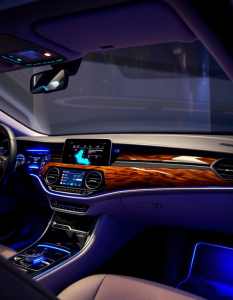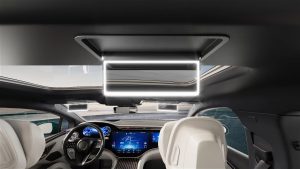As the automotive industry continues to advance toward greater intelligence and electrification, the smart cockpit has become an indispensable part of modern vehicles, serving as a critical interface for human-machine interaction (HMI). Smart cockpits integrate various advanced technologies, including artificial intelligence (AI), the Internet of Things (IoT), autonomous driving, and HMI systems, providing drivers and passengers with an unprecedented experience. In the future, how will smart cockpits evolve? This article explores the future of smart cockpits from multiple perspectives, including technological trends, user experience, safety, and ecosystem development.
1. Comprehensive Intelligence and Personalized Experience
Future automotive smart cockpits will leverage big data and AI to deliver a highly personalized user experience. Through sensors, cameras, and biometric technologies, the cockpit will automatically recognize the identity of drivers and passengers, adjusting seat positions, temperature, lighting, and entertainment systems according to user preferences. Whether for the driver or passengers, the smart system will cater to individual habits and needs, offering services such as personalized route suggestions and entertainment content.
Voice assistants and Natural Language Processing (NLP) will play a significant role in smart cockpits, allowing seamless interaction between the driver and the vehicle, thereby enhancing convenience and safety. Moreover, the cockpit system will continuously learn user behaviors, optimizing the experience and creating an increasingly intelligent driving environment.
2. Integration of Multimodal Human-Machine Interaction (HMI) Technologies
As smart cockpits evolve, HMI technology integration will become increasingly complex and diverse. In addition to traditional touchscreens and buttons, future cockpits will integrate multiple interaction methods, including voice control, gesture recognition, eye-tracking, and Augmented Reality (AR). For example, drivers may control the air conditioning or entertainment systems through gestures, or use eye-tracking for touchless operation, further improving driving safety and ease of use.
AR technology will also be a key component of future smart cockpits. With AR, vehicles can project navigation information and hazard warnings directly onto the windshield, allowing drivers to focus more on the road while staying informed about the surrounding environment in real time.
3. 5G and V2X Technology Empowering Smart Cockpits
The widespread adoption of 5G communication technology will provide robust support for smart cockpits. With high-speed, low-latency, and high-reliability characteristics, 5G will enable more efficient information exchange within the cockpit, facilitating seamless connection with external devices and platforms. For example, vehicles will communicate in real-time with other vehicles (V2V), infrastructure (V2I), and pedestrians (V2P) via 5G networks, enhancing the vehicle’s perception and improving autonomous driving safety.
Vehicle-to-Everything (V2X) technology, which forms the foundation of future intelligent transportation systems, will also become an integral part of smart cockpits. Through V2X, vehicles can interact with traffic lights and road monitoring systems to receive real-time traffic data, thereby providing more intelligent driving decisions.
4. Deep Integration of Autonomous Driving and Smart Cockpits
As autonomous driving technology advances, the design of smart cockpits will increasingly integrate with autonomous systems. With the gradual maturity of Level 3 (L3) and above autonomous driving technologies, drivers will be able to release control in more driving scenarios. Smart cockpits will shift from “driving assistance” to “driving supervision” and take over driving tasks when necessary.
Smart cockpits will not only assist driving but also serve as the core space for in-car entertainment and work. When a vehicle enters autonomous mode, the cockpit can transform into a “mobile office” or “home theater.” Passengers will be able to attend meetings, watch movies, or shop through cockpit screens, completely revolutionizing the way people travel.
5. Cockpit Safety and Privacy Protection
In the context of increasing intelligence and connectivity, cockpit safety and user privacy protection will become key concerns for the industry. With more sensors and cameras entering the cockpit, data security and privacy will be significant challenges. Future smart cockpits will require robust cybersecurity mechanisms to prevent potential attacks and data breaches.
Blockchain technology and edge computing may become critical tools in addressing cockpit security challenges. Blockchain can ensure the security of data transmission between vehicles, cloud servers, and devices, while providing transparent management of user data. Meanwhile, edge computing can process large amounts of data locally, reducing latency and further enhancing cockpit response speed and security.
6. Cross-Industry Collaboration and Ecosystem Building
The future development of smart cockpits will not rely solely on automakers but will require cross-industry collaboration and ecosystem building. Tech companies, component suppliers, software developers, and cloud service providers will all play vital roles in the development of smart cockpits. Through collaborative efforts, companies can jointly develop more advanced and intelligent cockpit solutions.
In particular, the deep integration of autonomous driving and smart cockpits means that future vehicles will no longer be mere transportation tools but intelligent platforms offering comprehensive services. By connecting with external ecosystems, future smart cockpits can seamlessly integrate with smart homes, offices, and more, extending the boundaries of in-car services.
Conclusion
The future of automotive smart cockpits will move toward greater intelligence, personalization, and multimodal interaction. With the integration of autonomous driving technology, 5G networks, and V2X communication, smart cockpits will significantly enhance the driving experience and safety. Furthermore, as cross-industry collaboration deepens, smart cockpits will evolve beyond being just driving tools into intelligent spaces for travel, entertainment, work, and daily life.







